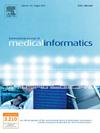药剂师采用电子处方
IF 3.7
2区 医学
Q2 COMPUTER SCIENCE, INFORMATION SYSTEMS
International Journal of Medical Informatics
Pub Date : 2025-03-14
DOI:10.1016/j.ijmedinf.2025.105877
引用次数: 0
摘要
在电子医疗记录时代,采用电子处方是提高医疗质量和保障患者健康的必要条件。因此,必须认识到推动采用电子处方的影响因素。尽管电子处方有许多优点,但卫生保健提供者和用户缺乏接受和抵制,这对其实施造成了障碍。本研究旨在找出影响药师采用电子处方的关键因素。方法采用描述性分析方法,随机抽取196名药师。本研究采用结合技术接受与使用统一理论(UTAUT)和任务-技术契合度(TTF)的概念路径模型,评估了药师在卫生服务中接受电子处方的倾向。结果UTAUT与TTF的整合有效地解释了药师采用电子处方的意向。具体而言,任务特征、绩效期望和促进条件对电子处方的采用表现出直接和实质性的影响。然而,任务-技术契合度、社会影响和努力预期对处方采用的影响未见报道。结论本研究引入概念路径模型来理解影响药师接受电子处方的因素。通过进行这项研究,确定了决定在保健服务中采用电子处方的基本要素。研究结果为从业人员、政策制定者和卫生部提供了宝贵的知识,帮助他们有效地设计和实施电子处方倡议。本文章由计算机程序翻译,如有差异,请以英文原文为准。

Adopting electronic prescribing by pharmacists
Introduction
In the era of electronic health records, incorporating electronic prescribing is imperative to improve healthcare quality and safeguard patient well-being. Therefore, it becomes essential to recognize the influential elements that drive the adoption of e-prescribing. Despite the numerous advantages of electronic prescribing, there is a lack of acceptance and resistance from health care providers and users, creating barriers to its implementation. This research aimed to identify the key factors that influence pharmacists in adopting electronic prescribing (e-prescribing).
Method
In this descriptive-analytical study, a total of 196 pharmacists were chosen through random selection. The study evaluated the pharmacists’ inclinations towards embracing e-prescribing in health services by employing the conceptual path model that combines the Unified Theory of Acceptance and Use of Technology (UTAUT) with The Task-Technology Fit (TTF).
Results
The findings demonstrated that the integration of UTAUT and TTF effectively explained pharmacists’ intention to adopt e-prescribing. Specifically, task characteristics, performance expectancy, and facilitating conditions exhibited a direct and substantial impact on the adoption of e-prescribing. However, the influence of task-technology fit, social influences, and effort expectancy on prescribing adoption was not reported.
Conclusion
In this research, a conceptual path model was introduced to comprehend the factors that influence pharmacists’ acceptance of e-prescribing. By conducting this study, essential elements that determine the adoption of e-prescribing in health services were identified. The study’s results provide valuable knowledge for practitioners, policymakers, and the ministry of health, assisting them in effectively designing and implementing e-prescribing initiatives.
求助全文
通过发布文献求助,成功后即可免费获取论文全文。
去求助
来源期刊

International Journal of Medical Informatics
医学-计算机:信息系统
CiteScore
8.90
自引率
4.10%
发文量
217
审稿时长
42 days
期刊介绍:
International Journal of Medical Informatics provides an international medium for dissemination of original results and interpretative reviews concerning the field of medical informatics. The Journal emphasizes the evaluation of systems in healthcare settings.
The scope of journal covers:
Information systems, including national or international registration systems, hospital information systems, departmental and/or physician''s office systems, document handling systems, electronic medical record systems, standardization, systems integration etc.;
Computer-aided medical decision support systems using heuristic, algorithmic and/or statistical methods as exemplified in decision theory, protocol development, artificial intelligence, etc.
Educational computer based programs pertaining to medical informatics or medicine in general;
Organizational, economic, social, clinical impact, ethical and cost-benefit aspects of IT applications in health care.
 求助内容:
求助内容: 应助结果提醒方式:
应助结果提醒方式:


